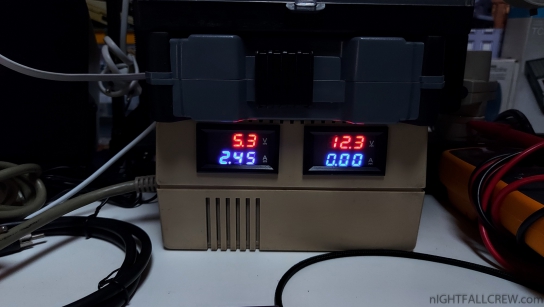
After the usual boring PSU recap i have decided to add two displays to monitoring the main voltages (+5,+12) and the amperage.
The amperage displayed with the blue LEDs in the left display is the sum of all the voltages (+5,+12,-12).
I have also added three ventilation holes, i didn’t want to use any fans, i already have enough fans in the lab that are quite annoying.
Gallery:
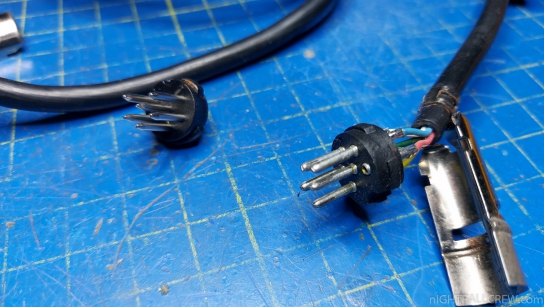
Texas Instruments PHA 2037 Connector FIX
Defect:
- Black Screen but sounds works.
Replaced parts:
Gallery:

Texas Instruments TI-99/4A Repair #1
Defect:
- Black Screen and deafening sound in background.
Replaced parts:
Texas Instruments TI-99/4A Repair #2
Defect:
- Wave/Raster Lines.
- Garbage on Boot Screen.
Replaced parts:
- 1 x Inductor 2 -> 4.5 μH (L100)
- 2 x TMS4116-15 RAM
Texas Instruments TI-99/4A Repair #3
Defect:
Replaced parts:
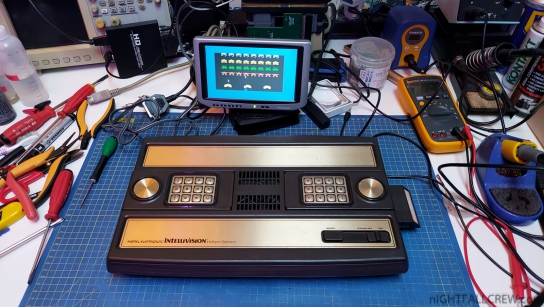
Video amplifier installation for Composite Video output including installation of the two female RCAs on the case.
I also made a simple fix of the metal PAD of the RESET that no longer stayed in place and consequently fell off inside the shell.
Gallery:

You shouldn’t turn on an Amiga that has been off for about thirty years without first running the usual Recap, but also following this simple rule it is not said that everything works as expected.
After the Recap i have realized that the RGB / Composite and RF output were not working properly.
From the RGB output the BLUE color was missing while the composite video and consequently RF show only a black screen.
After various measurements i came to the conclusion that the VP-101 (U30) DAC had to be replaced.
Once the DAC was replaced, the RGB output started working perfectly again, while the Composite/RF video signal they still didn’t work.
The failed component for the Composite/RF video output is the Z222 delay line, bypassing the delay line on the pins of the same one i have a “decent” composite signal but it’s not good, unfortunately this component is not easy to find, it could be solved by performing a “hack” i.e. by installing a different RGB Encoder that doesn’t need the delay lines and with some modifications on the PCB.
The game is worth the candle ? when will we use the Composite/RF video output ? probably never.
Gallery of the repair:
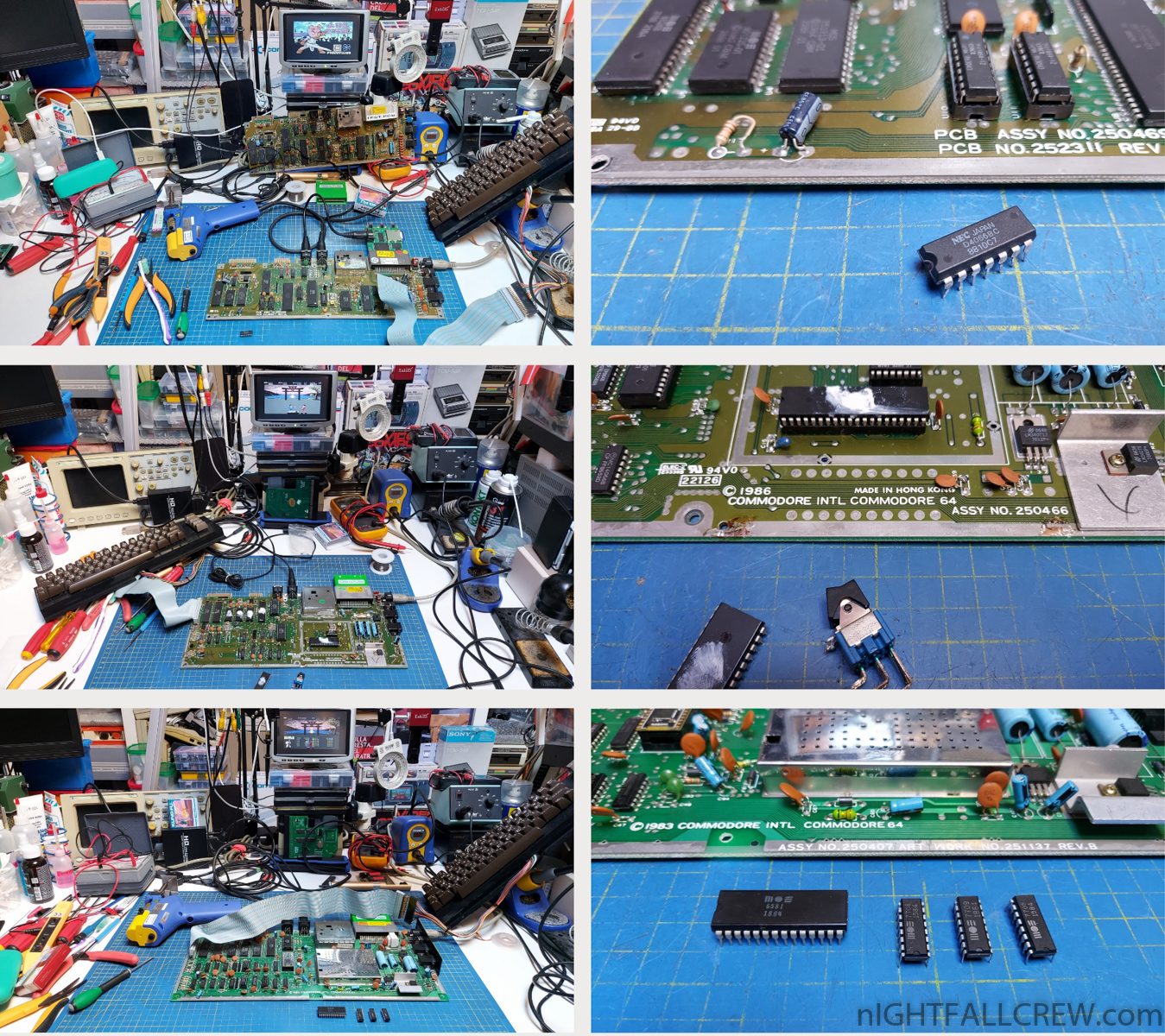
Commodore 64 (ASSY 250466) Repair
Defect:
- Black Screen and then Black Screen :-D
Replaced parts:
- 1 x Power Switch
- 1 x PLA 906114 (U17)
Commodore 64 (ASSY 250407) Repair
Defect:
- Garbled Screen and then No Sound.
Replaced parts:
- 2 x MOS 7708 [74LS257] (U13/U25)
- 1 x MOS 7709 [74LS258] (U14)
- 1 x MOS 6581 (U18)
Commodore 64C (ASSY 250469 REV-A) Repair
Defect:
Replaced parts:

This Amiga 1200 was sent to me by a friend to made the usual replacement of the capacitors and also overhaul everything and migrate the pcb to a new case with a new colored keyboard.
Works that have been done:
- Replacement of all electrolytic capacitors.
- Cleaning the expansion connector which was oxidized in some parts.
- General cleaning of the PCB.
- Kickstart OS3.2 installation
- Replacement electrolytic capacitor in the Panasonic JU-253-043P Floppy Drive
- Floppy Drive Cleaning.
- Greasing of Floppy Drive mechanical parts with silicone grease.
- Painting of the Floppy Disk eject button with matt Black color (Only the black button for Chinon Floppy Drive is supplied with the new case)
- CF Card adapter fixing.
- Installazione PCB and colored keyboard in the new case.
- Functioning test with Floppy Disk and CF Card.
Gallery:
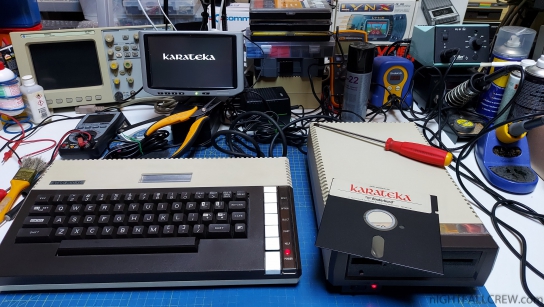
This drive has two different problems.
- The Floppy Drive just did not turn on.
- The motor spinning always, regardless of whether a Floppy Disk was inserted or not.
Repair:
The Floppy Drive could not work because the FUSE inside the external power supply (transformer) was missing. :-D
The second problem was caused by the RAM-I/O-Timer (RIOT) 6532 which had decided to stop working.
Replaced the RIOT and made a good cleaning and greased some mechanical parts with silicone grease, everything has started again to work better than before. :-D
Gallery of the repair:
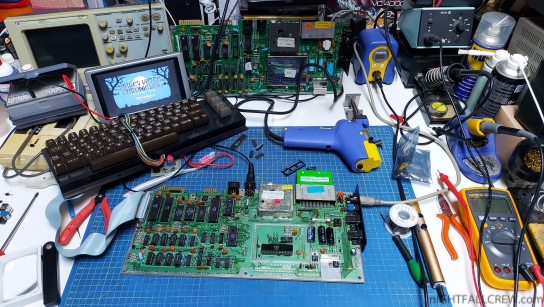
This poor Commodore 64 already been previously repaired by me but soffer of these new problems.
- Out of Memory
- Black Screen
- No Cursor.
- Garbage screen.
The problem of the black screen at irregular intervals with the out of memory was solved by replacing the CPU 6510, as soon as the CPU warms up a little more than normal the computer displayed only a black screen, cooling the CPU still did not work but at least something was displayed.
The problem of the out of memory are 4 dead ram + 1 previously replaced and i have decided to put in a socket the remain 3.
Last problem, there was no cursor and sometimes a garbage screen was displayed, as we all know the CIA 6526 in position U1 should be faulty due to the missing cursor.
Instead of CIA 6526 it was the socket of the 6569R3, replaced the socket the cursor is back and other annoying glitches disappeared.
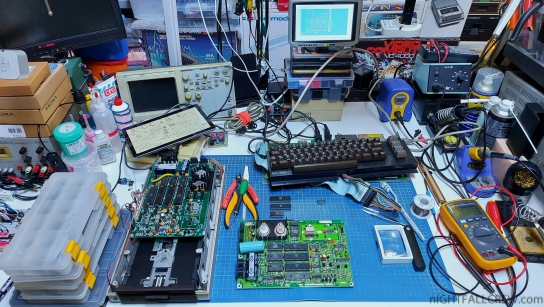
Commodore Floppy Drive 1541 (1540050) Repair #1
Defects:
- Drive access problems (IEC): drive resets but the computer freez with a “searching for”
- The RED led flashes twice times then stops and start again and motor runs continuously.
- The RED led flashes repeatedly every second without stopping and motor runs continuously.
Replaced parts:
- Replaced 6522 (UC3)
- Replaced 6522 (UC2)
- Replaced 901229-03 ROM (UB4)
Commodore Floppy Drive 1541 (251830) Repair #2
Defects:
- The RED led flashes repeatedly every second without stopping and motor runs continuously.
Replaced parts:
- Replaced MOS 8713 [74LS04] (UC6)

The Amiga scene has been dead for me from several years, long life to the Commodore 64.
Taken from a deadly boredom i have decided to do this useless hardware update of one of my Amiga 1200.
I personally updated the A1208 memory expansion with the Clock section because i had the order wrong, old age strikes again.
This is just a small update to my post.
I added another useless thing to this update … unfortunately in this case it is useful because without the 4xIDE Buffered IDE interface
the CF<>IDE adapter inserted in the trapdoor on the right side of the amiga which uses an IDE cable longer than 10-15cm, DOESN’T WORK generating a mix of reading/writing errors from the CF.
Aware of the problem, i still wanted to try, in fact in an old Amiga 1200 i had the IDE-Fix Express with IDE-Express Adapter bought 12 years ago, then sold.
So i confirm it doesn’t work, even if they write exactly the opposite (see ebay announcements)
Gallery of the useless update:
source: amigaisdead.com amigastore.eu amigakit.amiga.store
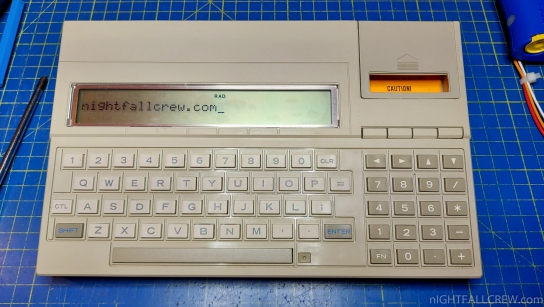
The Texas Instruments Compact Computer 40 or CC-40 is a battery-operated portable computer developed by Texas Instruments and released in March 1983.
An improved model, the CC-40 Plus, was in the final stages of development and included a cassette port. The project was canceled when Texas Instruments discontinued the 99/4A and left the home computer field.
Repair:
The computer was compressed inside the shipping package, obviously it was very badly packed.
The PCB that is installed on top of one of the two motherboards of the computer (see photo) is broke, interrupting some pcb tracks, it was enough to reconstruct the pcb track and the computer started working again.
Gallery of the repair:
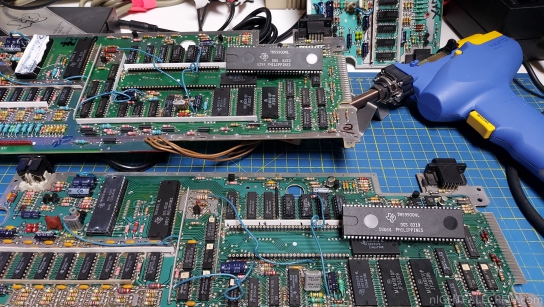
5 x TI-99/4A (PAL) motherboards with various defects repaired
Defect:
- TI-99/4a #1: The metal shield that protects the pcb is loose and some parts create short circuits on the pcb.
- TI-99/4a #2: TMS 9918 (U100) VDP inserted in the wrong way (:/), incredibly it did not burn.
- TI-99/4a #3: TMS 9900 (U600) Dead CPU.
- TI-99/4a #4: TMS 9900 (U600) Dead CPU.
- TI-99/4a #5: Apparently working. (Notes: left ON for over 4 hours did not present any problems)
Gallery of the repair:
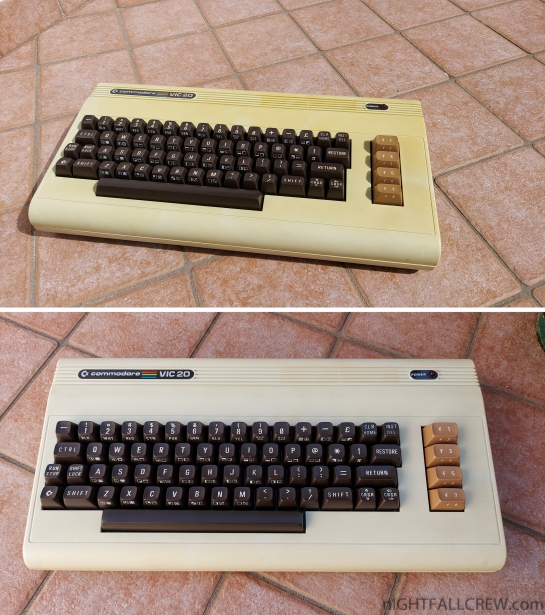
I have not discovered absolutely anything new, it is all explained in these video:
https://www.youtube.com/watch?v=8P1OVj0IcqY
https://www.youtube.com/watch?v=4eBynrpdLdk
I’m absolutely against retrobright but i wanted to try with a yellowed Commodore VIC-20 / Amiga 1200 Keyboard and Amiga 1200 TOP Case.
Many people told me to try, but disagreeing with this technique, i never did, but later my friend Federico di Dato of Retrobitlab has tried it and actually seemed to work, i state that i did not believe it right away, the first thing i thought; it seemed like a cosmic bullshit.
Ok, i have to change my mind, it works!, below are the various phases and times of exposure to the sun (a beautiful sunny day!)
VIC-20 (front):
- Let’s start with the first photo just exposed under the sun, then 6 hours, +7 hours, 7 hours, so a total of 3 days = 20 hours.
VIC-20 (back):
- Let’s start with the first photo just exposed under the sun, then 2 and a half hours, 7 and a half hours so a total of 2 days = 10 hours.
Amiga 1200 Keyboard:
- Let’s start with the first photo just exposed under the sun, then 7 and a half hours x 3 days = 22 and a half hours.
Amiga 1200 TOP Case:
- Let’s start with the first photo just exposed under the sun, then 7 and a half hours x 3 days = 22 and a half hours.
I have not used any chemical product, there is nothing more to say.
Lightbrighting technique:
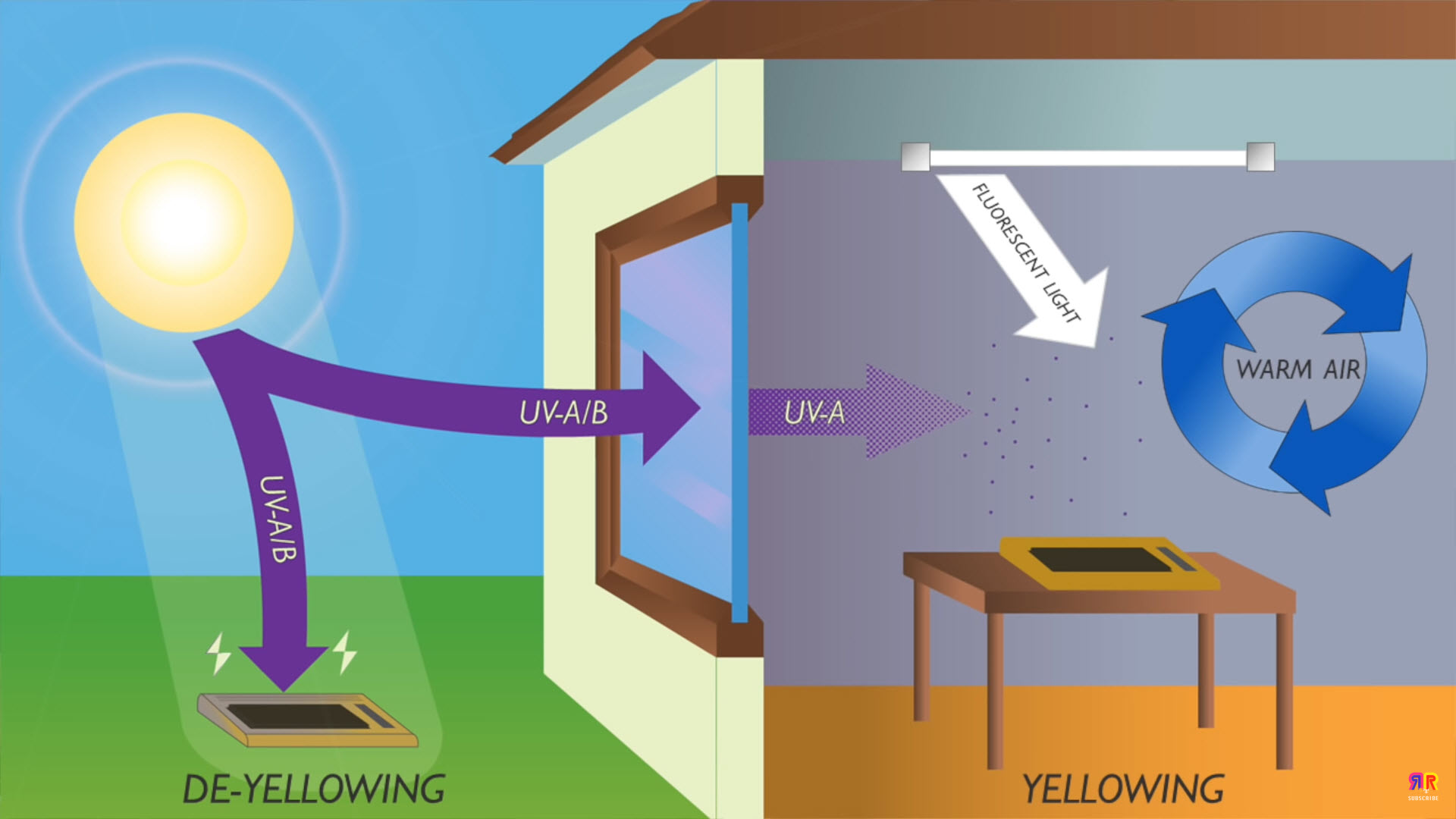
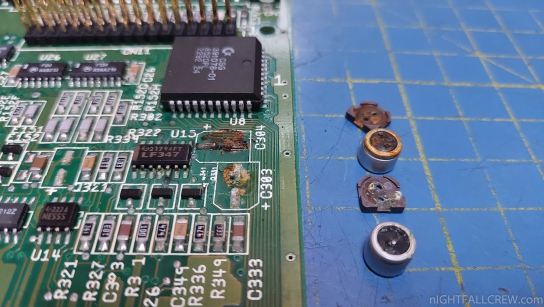
This is the usual post about replacing Amiga Electrolytic Capacitors.
Unlike the Amiga 1200 which had no problem with acid leaking from the capacitors but in any case i have replaced them, the Amiga 600 is in a dramatic state but with a little patience and a good cleaning everything started working perfectly again.
Yes, to remove the capacitors i did the much-hated “twist” of the component, ok, having said that, the job went well so don’t broken my balls, thanks.
Gallery of the repair:























































































































Recent Comments